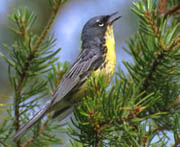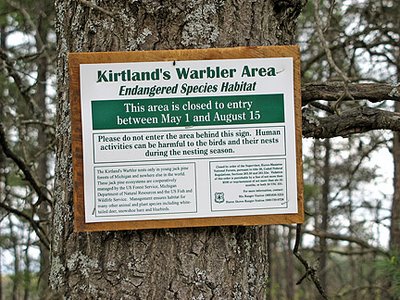 |
 |
|
 Kirtland's Warbler Kirtland's Warbler
The Kirtlandís Warbler, a federally listed endangered species, is one of the worldís rarest birds. Its only consistent breeding grounds is the dense jack pine forests in Michigan's Lower Peninsula in an area 100 miles long and 60 miles wide within the Au Sable River drainage area. These birds were known as the "bird of fire" because intense heat is needed to open the jack pine cone and release the seeds. The Kirtland's Warbler requires areas with small dense jack pines for nesting. The warbler first appears in an area about six years after a fire when the new growth is very dense and is about 5-6 feet high. After about 15 years, when the trees are 10 to 15 feet high, the warbler leaves the area. I photographed this Kirtland's Warbler singing from the top of a jack pine near the AuSable River. Between 1961 and 1971 the population had dropped by 60%. By 1987, the total population had dropped to 167 singing males. One reason for the decline was the loss of habitat caused by improvements in wildfire prevention. Without fires, the jack pine cones do not open. Without opening and disbursing the seeds, new trees do not grow and the existing trees become too tall and spindly to secretly conceal the warbler's ground nest. The second reason for the decline is caused by the parasitic brown-headed cowbird which lays it's eggs in the warbler's nest. The Kirtlandís Warbler does not recognize the imposter's eggs, and consequently, they spend their time raising cowbirds. The cowbird eggs hatch before the host warbler eggs hatch, get fed first, and grow quickly. Since the cowbirds are larger, they can keep the food from the hostís young. Prior to 1972 , each warbler nest only averaged one fledged bird, mainly due to cowbird parasitism. The result of cowbird population control has brought that number up to an average of three per nest.  The U.S. Forest Service, the U.S. Fish and Wildlife Service and the Michigan DNR are annually maintaining nesting sites by a combination of clear cutting, controlled burns, seeding and tree plantings to mimic a forest fire. Approximately 150,000 acres of sandy highlands, including National Forest land in northern Iosco County, are set aside for the Kirtlandís Warbler. These areas are on a rotational plan to make sure the Kirtlandís, as well as other species of plants, songbirds and game animals have the habitat they require. Seventy percent of recently nesting Kirtlandís were found in "created plantations". The goal is to have 2,000 birds and to sustain this number through the rotation of habitat. To learn more about the Kirtland's Warbler, and information about U.S. Forest Service guided tours to nesting areas, visit this link ..........  | Tuttle Marsh Wildlife Area | Iargo Springs | Kirtland's Warbler | | Return Home | Clothing & Outerwear | Footwear | Cross Country Skiing | Kayaking & Canoeing | Tawas Bird & Nature Observation | Fly Fishing | Corsair Ski Trail Conditions | Hiking & Backpacking | Events Schedule | Contact Us | |
||
 |
 |
